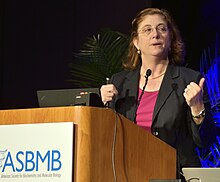Susan Baserga | |
|---|---|
 Baserga receiving the 2016 American Society for Biochemistry and Molecular Biology William C. Rose Award | |
| Alma mater | Yale College Yale School of Medicine Yale University |
| Scientific career | |
| Institutions | Yale School of Medicine |
Susan J. Baserga is an American physician who is the William H. Fleming Professor of Molecular Biophysics and Biochemistry at Yale University. Her research considers the molecular basis of ribosomes, and the mechanistic basis of inherited human disease.